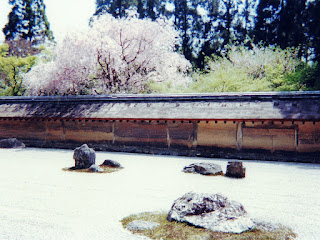My first day's itinerary covered the city's eastern flank. This included Ryozen Kannon (the city’s War Memorial temple), Sanjusangendo Temple (home to 1000 Kanon idols), and the iconic Kiyomizudera Temple. Kiyomizudera was particularly memorable. I loved its hillside views of the surrounding Sakura in full bloom.
I started the day with a morning visit to Ninomaru Palace filled with an array of imperial artefacts, before crossing the neighbouring moat into Nijo Castle. The image above shows Karamono, the main gateway into Ninomaru Palace. From here it was on to Heian Jingu shrine and then to Nanzen-ji Temple, before heading south to Kiyomizudera.
Kiyomizudera (literally "Pure Water Temple") is one of Japan's most celebrated temples. It was founded in 780 on the site of the Otowa Waterfall in the wooded hills east of Kyoto. Its name speaks of the waters from the fall. Kiyomizudera is best known for a wooden stage extending from the temple's main hall, 13 meters above the hillside. Balconies along its flank offer stunning views across the area's tree-clad hills and the city of Kyoto beyond. The blossoms were in full force during my visit.
Behind Kiyomizudera's main hall stands Jishu Shrine, a shrine dedicated to the deity of love and matchmaking. In front of the shrine are two stones, placed 18 meters apart. Successfully making your way from one to the other with your eyes closed is said to bring luck in finding love. You can have someone guide you from one stone to the other. However, this is interpreted to mean that an intermediary is also required in your actual love life.
As the sun began sinking, I made a last-minute decision to backtrack and visit the less impressive Ginkakji Silver Pavilion. I then finished with a memorable sunset walk to the train station via the picture-perfect Philosopher’s Path.
This 1.5km paved walkway follows a tree-lined canal winding through the city’s eastern suburbs. This walk proved a spectacular finish to the day. As I walked, I was continually showered by gently falling petals. I honestly can’t think of a better way to experience the magic of Sakura season.
As the sun began sinking, I made a last-minute decision to backtrack and visit the less impressive Ginkakji Silver Pavilion. I then finished with a memorable sunset walk to the train station via the picture-perfect Philosopher’s Path.
This 1.5km paved walkway follows a tree-lined canal winding through the city’s eastern suburbs. This walk proved a spectacular finish to the day. As I walked, I was continually showered by gently falling petals. I honestly can’t think of a better way to experience the magic of Sakura season.
The Golden Pavilion is the city's postcard idol. It's a three-tiered structure set on the shore of an exquisitely manicured lake. The pavilion's top two storeys are clad in gold leaf that glistens spectacularly whenever the sun shines. Throw in a few cherry blossoms and you've guaranteed an absolutely breath-taking experience.
I simply loved the moss garden set into the hillside behind Ryoanji Temple, with the Kogetsudai mound coming a close second. This mound is a seamless conical mound constructed entirely of loose pebbles. I have no idea how the local monks kept in such flawless condition. Its perfection captures the essence of Japanese society - a combination of simplicity, elegance, and highly disciplined organisation.
However, having said this, Japan also has plenty of quirks. None more so than the ubiquitous presence of vending machines offering all manner of snacks, drinks and other daily necessities. You can even buy a cold Asahi beer (no ID required), or soft porno if you know where to go - I kid you not!
You'll often find machines installed on random corners of suburban streets and along nondescript laneways. Need help finding my house? Just look for the Coke machine outside. Although I find it ironic that the Japanese considered it poor form to walk and eat or drink in public. To this day I still don't know where the locals go to consume their vended treats?
Finally, a little cultural highlight. The uniquely Japanese performance art of Bunraku originated in Osaka. It dates back to the 17th Century and blends complex puppetry with musical accompaniment and a chanted narrative. The lifelike puppets are beautifully handcrafted with elaborately decorated costumes and many individualized moving parts, giving them a full range of expression. These articulated puppets are so large that they require three puppeteers to operate them.
Osaka is home to the National Bunraku Theatre. It puts on shows several times a year. My visit coincided with one such performance so I decided to treat myself to a unique cultural experience. Bunraku productions are either historical plays, such as the heroic revenge drama Chushingura, or romantic tales which dramatize the conflict between personal emotion and social obligations. Each performance can last up to three hours.
Sadly, I must confess that I lasted about an hour before declaring myself a Bunraku philistine. While the puppets were impressive, I was surprised to discover that the scenery and props were less elaborate and changed rarely during the show. After an hour or so of chanting in a language I didn't understand, coupled with the knowledge I had at least another 90 minutes to go, I decided I'd experienced enough culture. I quietly made my exit during one of the show's darkened scenes.
Chion-in Temple Gate


























No comments:
Post a Comment